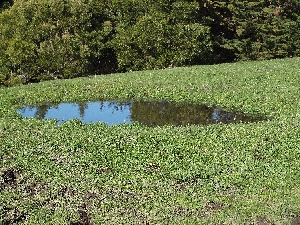Viking influence in Early Aoteaora New Zealand.
Where I live in New Zealand there are pre-European earthworks consisting of very level terraces surrounding a hilltop which is part of an old Pa site. The terraces are about 4 to 5 metres wide, and set into them are dugouts or pits.

Close to 150 metres away, on the middle of a small rising ridge there is a dew-pond, as would be found say in Ireland. In the image, the water at that level is 4m across. (Heavy cattle pressure has filled it in a lot). It is the only pit out of well over a hundred that is designed to hold water.
200 meters away from the dugouts in another direction there is large hill-like mound, considered by many to be a burial-mound, similar to those burial mounds found in the U.K.
Over the years several renowned people in their fields of expertise; archaeology, anthropology, history and other, have visited the old Pa, and conversation invariably goes to the U.K., and England in particular because of the similarities in earthworks. Celts, Normans, Vikings and other cultures are mentioned. Even a dozen people from the Māori Land Court came, and with some enthusiasm began conversation with a local historian about the similarity to a place that they both knew of in England. There is no mention of Polynesia.
Much of all this is mentioned in the attached video, in which I also named a few pertinent books, and quote my latest treasure, a book written by Frank O. V. Acheson called PLUME OF THE ARAWAS . Frank Acheson was a Judge in the Native Land Court in the early 1900's and had a deep love and insight into the native people. The book was first published in 1930 and was published with consultation and the blessing of the then Māori elders.
In chapter eight of part four ..the chapter heading and sub-heading reads:
Whence may come the terms of peace so lasting,
That rage and battle-strife will cease to be.
It is as though it is prophetic of this period that this 'plume' is opening up today. That it will burst through, and the terms of lasting peace may come. The chapter is readable online at NZETC and the following is from page 283, when Nukutea, the High Chief begins speaking to Tuwharetoa:
"Thus do I come to the point where I left off last night, for the stranger chief who took to wife the daughter of Hui-te-Rangiora on Little-Hawaiki was of the White race. According to tradition he was a man of very fair skin, and had blue eyes, and had fair hair of a distinctly reddish tinge. But the most extraordinary thing about that man, was that from just above his ears there grew two small wings, one on either side of the head. ..
..Tradition records also that the stranger chief was the eldest son of the ruler of some cold country far away in the north, and that he was a great voyager, and an expert at navigating a vessel upon the ocean. Indeed, it would seem that he taught our people much that was of value to them later in their migrations across the sea. Ah! There is a question hovering upon thy lips, O Arawa. His name? His name was 'Erika'."
Acute disappointment filled the mind of Tuwharetoa, for the name "Erika" was a new name to him, and strange name. Now the names" Hui-te-Rangiora" and "Puhi-Ariki" had been quite well known to him, for they were on his own line of ancestors in the whakapapa or pedigree handed down from Ngatoro-i-rangi. But, according to that whakapapa, Puhi-Ariki had married the Sea God Tangaroa. "Erika"? That was surely not a Māori name?
"His name was 'Erika,'" repeated Nukutea, "but, because he pronounced his name as if its ending had been bitten off, Puhi-Ariki did not like that name. Therefore, upon her marriage to Erika, she gave him a new name, the name Tangaroa. Ah! That name is known to thee, O Arawa? Taihoa!"
"In due time sons were born to Puhi-Ariki and Tangaroa, first one son and then another, and they also had blue eyes and had fair hair somewhat reddish in tinge, but their skin was shaded with brown. According to our traditions those two sons of Puhi-Ariki were the first 'urukehus' born to the Maori race, and in later times their descendants preserved their characteristics and were referred to often as 'the fair-haired offspring of the Sea God Tangaroa.'
"Now, after the birth of his second son, Tangaroa, departed from Little-Hawaiki in his queer-shaped vessel, voyaging to the eastward in an effort to find a new track to his home country in the north. But though he promised to return, he came not back.
"Years passed, and then the grief-stricken Puhi-Ariki with her two sons joined Hui-te-Rangiora in one of the migrations proceeding to the east, in the hope that in some way or other she might reach the unknown country whither her loved one had gone."
Well, Gods are humans, and the book says to me quite plainly, that the Sea-God Tangaroa is a Viking, a Norseman or a north man. I suggest a person should read the book as the whole story is really quite wonderful. I particularly enjoyed the chapter of the battle of the waka on lake Taupo. So many questions I had became answered. The book often appears on Trademe, or read it online it the link above.
People of many different etnic origins inhabited the land prior to Capt. Cook arriving here, and as happens with modern mankind, all became lumbered (here since the 1840 Treaty) under one banner of 'Māori', as did the many hundreds of those with different ethnic origins of North America who became treated as 'Indians', with their true identities often becoming confused and lost.
Metoikos